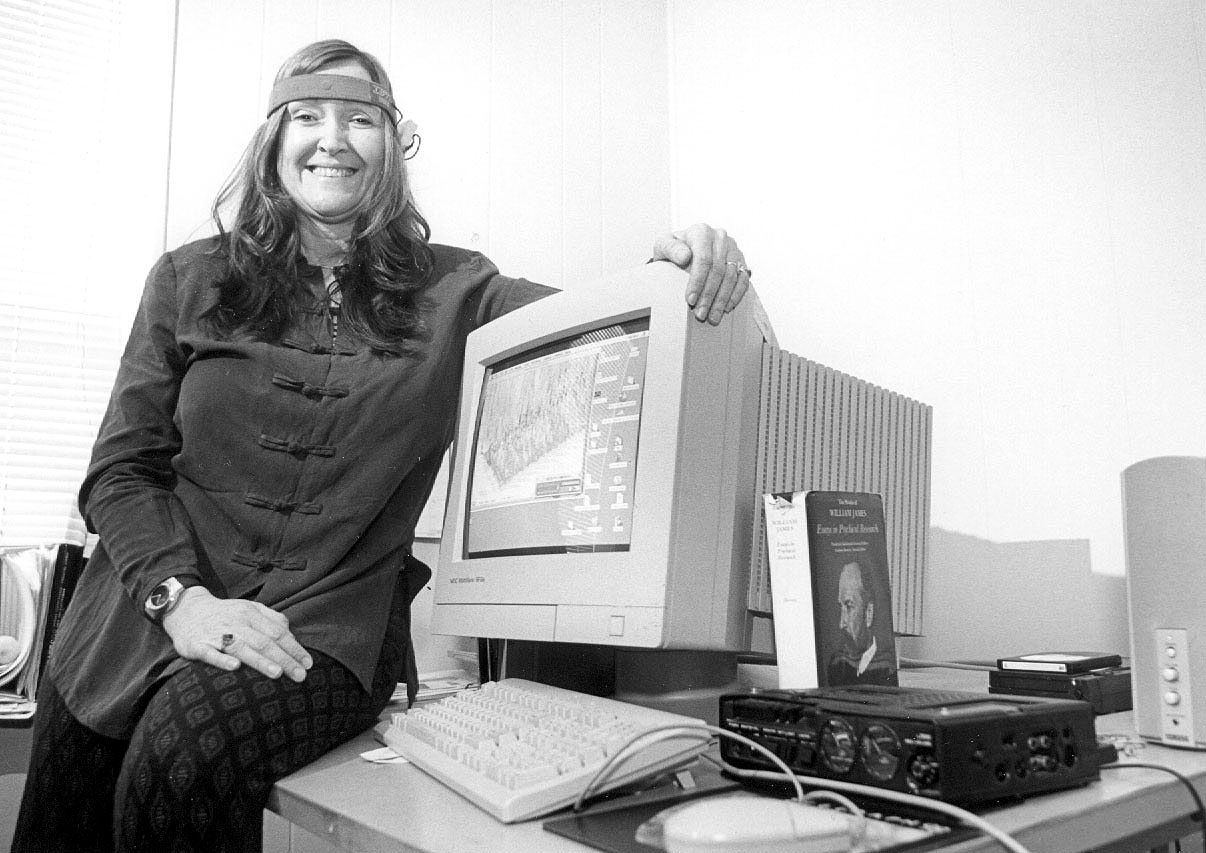Contact: Kay Fike Jones

MSU assistant art professor Paras Kaul
demonstrates brainwave art.
When Paras Kaul gets ready to create a work of art, she doesn't pull out brushes and paints. Instead, she fastens electrodes to her head and "thinks" an image onto her computer screen.
In her multimedia art classes at Mississippi State University, the assistant professor employs a truly thoughtful technique called neural audio imaging. Usually referred to by the acronym NAI, the procedure uses brain waves to operate a computer and create images.
A California native who also goes by "That Brainwave Chick," Kaul teaches students how to relax and "focus on their cognitive potential." Using specialized software, her students are able to produce computer images that change according to their states of relaxation. Colors can range from bright pink for "agitated" to soft blue for "relaxed."
"The system utilizes standard electroencephalogram (EEG) analysis similar to what is used in hospitals," Kaul said.
Explaining further, she said an electrode-fitted headband and a transmitter are hooked to a computer using the Interactive Brainwave Visual Analyzer System. The result: various visual and audio effects created by different brainwave frequencies.
Kaul, who joined the MSU faculty last year, holds bachelor's degrees from James Madison University in Harrisonburg,Va., and California State University in Sacramento, where she also completed a graduate course in photography. She earned a master's of fine arts degree at the School of the Art Institute of Chicago.
Since coming to Starkville, she has used the audio components of NAI to conduct visual music presentations with MSU associate music professor Mark Applebaum.
In these "concentration concerts," Kaul is connected to the computer, which is connected to a piece of audio equipment--a MIDI interface--which is connected to a variety of sound modules. While not exactly toe-tapping dance selections, the process literally gives voice to "tunes" bouncing around in her brain.
"While the brain tends to 'jump around' naturally, the video and audio results can be controlled to various degrees," Kaul said. Understandably, persons with backgrounds in yoga or meditation seem better able to control the presentations, she added.
Aside from exploring its entertainment value, Kaul is interested in using NAI to enhance relaxation for specialized learning needs. Preliminary research seems to indicate that neural imaging can lead to relaxation and reduced stress, she said.
Kaul said a more important reason, however, could be NAI's potential to aid the healing process. She recalled a personal incident involving a child who had lost all mobility as the result of a car accident.
"She was wired up to the computer in order to control a happy face on the screen through her brainwave activity," Kaul said. "I would like to think that this use of neural imaging offers the possibility of helping severely injured persons have a better quality of life."
Among her other activities, she is working with the Cave Automatic Virtual Environment designer to develop a brainwave interface. Housed at MSU's National Science Foundation Engineering Research Center, CAVE is a room-sized, three-dimensional video and audio theater.
She also expressed hope that the NAI technology can lead to the development of neurological learning tools.
"Relaxed students pay more attention in the classroom, making learning easier," Kaul explained. "Incorporating these learning tools into our educational environment could lead to a new way of learning that isn't dependent solely on memorization."
Kaul's web site, webserv.art.msstate.edu/opening1/main.html, includes samples of NAI, as well as other artistic endeavors of her multimedia students and herself. She also has founded OKSIGGRAPH, a professional chapter of the SIGGRAPH (Special Interest Group for Computer Graphics and Interactive Techniques) organization for Oktibbeha County. For information on this group, e-mail Kaul at paras@ra.msstate.edu.